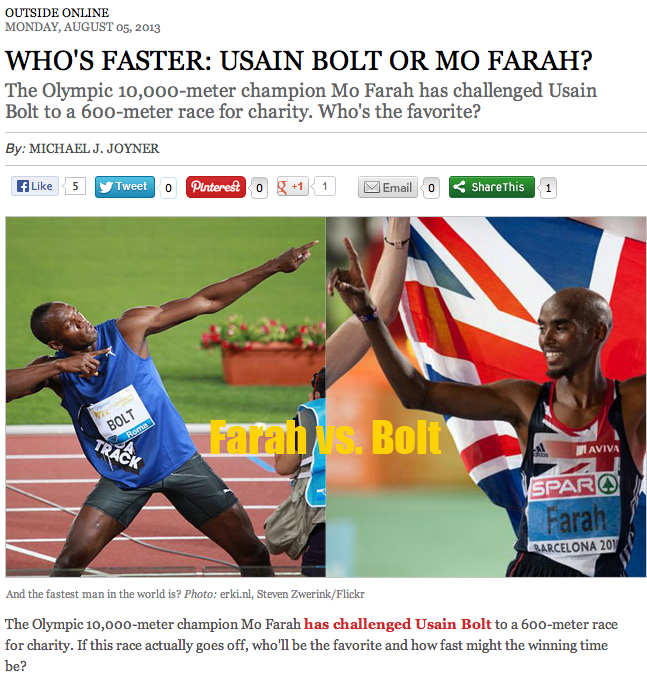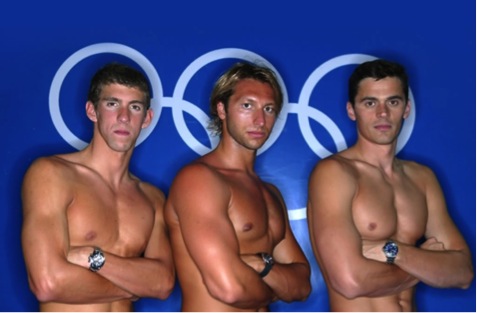Archive for the ‘Current Events’ Category
Outside Online: Stop Skipping Breakfast
Depending on the pace of posting for Outside Online, I might be generating less independent material for Human Limits. Here is the most recent Outside Online post. Enjoy!
click for article
The A-Rod Game
Alex Rodriguez (A-Rod) was suspended for 200 games by major league baseball based on “non-analytic” evidence of doping, most recently as part of the “Biogenesis” scandal in south Florida. He was one of 13 players suspended and his suspension is the longest doping suspension in major league history. Like Lance Armstrong he “passed” any number of drug tests. That having been said, there was a terrific article a couple of weeks ago in the Economist about “game theory” and doping in sports. The idea is that the athletes are in a game with each other. If testing and enforcement are lax, then (depending on the rewards for a superior performance) the risk of getting beat by a doper is greater than the risk of getting caught.
The Bud Selig Game
The athletes are also in a game with the authorities. More importantly the authorities are in a game with the fans. Incredible performances increase fan interest and so a cynic might argue that the owners want the appearance of compliance more than a truly clean game. This charge has been leveled at Baseball Commissioner Bud Selig who has been accused of turning a blind eye during the Mark McGuire, Sammy Sosa, and Barry Bonds homerun derby era after the 1994-95 baseball strike. One argument about the Lance Armstrong case is that the cycling authorities knew what was going on but were more than happy to have Lance win year after to year to “grow” the interest in their sport in the U.S. which was a relatively untapped market compared to Europe.
The Yankee Game
The Yankees signed A-Rod to a huge long term contract. To what extent are they more than happy to see him more or less go away so they can “head in a different direction”?
The Other Games
Here are some other games that are being played:
- As I have pointed out numerous times, testing is beatable on many levels. Who are the authorities trying to fool?
- Testing in U.S. professional sports is generally less rigorous than WADA based testing used in the Olympics, and WADA based testing is still beatable.
- There is a lack of transparency. Post who was tested how often but after the tests were performed. Then post the results. This would increase confidence among athletes about “unilateral disarmament” and also let everyone see if any stars were in fact being protected. It would also essentially crowd source scrutiny of high normal values, and I bet there are plenty.
- What about unregulated anti-aging clinics that sell all sorts of hormone based potions to all sorts of people? When Jane or Joe six-pack can essentially get drive through hormone treatment to buff themselves up, why not ballplayers?
Suspend Bud Selig?
A-Rod (like Lance Armstrong) is not a person I want to defend. However, he is just one dishonest cog in the machinery of denial. If he deserves to be suspended then so does Bud Selig for either turning a blind eye or never looking very hard in the first place. Does anyone really believe that the hard-nosed billionaire owners did not know what was going on? Are they cracking down now because they finally woke up or because their checkbooks are talking?
Usain Bolt vs. Mo Farah
The thought of a match race between Usain Bolt and Mo Farah over 600m has captured a lot of attention. Here is an analysis I did for Outside that followers of Human Limits might be interested in. I just hope this race comes off.
Mike
click for article
Innovation and the Industrial Revolution
I was in the UK last week and toured Coalbrookdale which in many ways was the Silicon Valley of the Industrial Revolution. This area of England had easy to access coal and iron ore, was near a river and there were numerous skilled craftsmen in the region. In the late 1600s and into 1700s much of the ground work for industrialization occurred here. This included replacement of wood with coal, improved and more efficient iron production, primitive railroads, and a number of other innovations. On a very simple level they ran out of wood for fuel, replaced it with coal, and when the coal mines got deep enough they needed to pump water out of the mines to keep digging and thus an early version of the steam engine was developed. So, they literally made it up as they went.
At the same time innovations in metallurgy (some derived from beer production) led to early mass production. As things progressed, people like James Watt made further improvements in the steam engine and water power could then be replaced by high efficiency steam engines and “progress” accelerated further. Other factors like intellectual property, finance, and even religious dissent play a role in all of this. For example, religious nonconformists who did not have equal access to traditional economic opportunities drove much of the innovation. The picture below is of the first iron bridge ever built in 1779 across the river Severn. The point of all of this is that a number of factors came together in the region over time and none of it was centrally planned “in London”.
Fast forward to what has happened since World War 2 in Silicon Valley you can see some of the same sorts of general trends. A lot of technology and skill sets that can be mixed, matched and improved to solve problems. There is also plenty of IP, finance and folks with “nonconformist” world views in Silicon Valley. The absence of central planning is also notable. In fact some large companies like Xerox “developed” prototypes of the modern electronic world but did not know what to do with them because they did not fit into an easy to identify business model. The video below shows the beginning of a presentation given in 1968 by Douglas Engelbart (the inventor of the computer mouse) that essentially describes the modern electronic environment that many of us work and increasingly live in. Like the innovators of the Industrial Revolustion he had many sources of inspiration for his ideas.
click for video
Take Home Messages?
I am not sure what the take home messages about innovation from Coalbrookdale and Silicon Valley are, but it seems to me that innovation is frequently bottom up and not top down and that the key for individuals and organizations is to recognize it when they see it and then figure out a way to say yes and cultivate it. The temptation is always to keep doing things the “same old way” and perhaps do them harder, faster or more efficiently vs. differently in a fundamental way. I think the other message is that crisis and opportunity are flip sides of same coin. My guess is that the scarcity of wood was a major crisis for some people, but at the same time but also a major opportunity for others. The question for us all is how to turn our problems into opportunities.
Top This Gary Player!
I have devoted a couple of posts to 77 year old golf legend Gary Player and his lifelong devotion to fitness. In response to my most recent post a reader sent the video clip below about 86 year old gymnast Johanna Quass. I have been thinking about exercise and aging for a long time, but the clip below is among the most remarkable things I have ever seen. Clearly a lifetime of training, talent, and injury avoidance are required to make a performance like that happen. However, nothing like it happens without staying with it.
click here for video
I have been doing more body weight calisthenics and strength training over the last year, but this video has me thinking maybe I should take a tumbling class or start jumping rope again like I did in high school to improve my footwork for basketball. In the end, loss of strength and balance leads many older people to become frail and lose their independence, maybe we need to rethink what we tell middle aged people to literally keep them independent and off the floor.
Healthy After 65
Today’s post is a short one and focuses on a new CDC report on healthy life expectancy (HLE) at age 65. This differs from total life expectancy (LE) and is a measure of how long the average person can expect to life in reasonably good health after they hit 65. It is important because data like this can help individuals, families, governments, and other organizations think about health and other services that older people will need over time. The figure below shows estimates based on 2007-2009 data. For those who want to take a deeper dive, the report is full of all sorts of information on the effects of sex, state, and race on healthy life expectancy. In general women do better than men; there is substantial regional variation with issues in the South especially and blacks do worse than whites.
Here is the bottom line from the CDC report:
“For the total population at age 65 years, HLE was lowest among southern states. For all persons at age 65 years, the highest HLE was observed in Hawaii (16.2 years) and the lowest was in Mississippi (10.8 years). During 2007–2009, HLE as a percentage of LE for persons at age 65 years for the total U.S. population ranged from a low of 61.5% in Mississippi to a high of 78.2% in Vermont (Table). Conversely, the number of remaining years in fair or poor health for persons aged 65 years was 6.7 out of 17.5 years of LE for those living in Mississippi and 4.2 years out of 19.4 years for those living in Vermont.”
My bottom line is that this regional and other differences noted in the report are not going to be solved by medical care alone and that some areas of the country need aggressive public health interventions to catch up. These topics have been covered many times in earlier posts on life expectancy.
Post Tour Doping Thoughts
The Tour de France ended yesterday and I wanted to use it to continue to highlight issues related to sports doping. Since the tour started, there were a number of busts in the track and field world apparently related to the use of a banned stimulant by Tyson Gay and several sprinters from Jamaica. Ultimately athletes are responsible for what goes into their mouths or bodies via other routes, but adulteration of “supplements” with banned substances is both a real problem and a convenient excuse.
1% is a Big Deal
The other issue I want to bring up is that a 1% edge in something like a 10,000m run would be a huge margin of victory (100m) or a huge improvement (~16-17 seconds for a world class runner). If you simply translate this to the Tour de France which lasts about 80-90 hours it would be about 50 minutes. That is unrealistic due to the team tactics and the fact that every day is not a test for the top riders. However, this year there were more climbs than normal and perhaps 8 or 10 hours that might have been decisive, so 1% would be a 5-6 minute margin. If you believe that drug tests and the biological passport are beatable with low dose drugs, a doping regimen that generates a 1% edge while remaining undetectable seems conceivable to me. Lance Armstrong and his collaborators showed what is possible when the East German approach was privatized and there is more than enough at stake with a Tour win to tempt people to learn to fly under the doping control radar.
Show the Data
My colleague Ross Tucker, one of the World’s leading experts on human performance, has called for more transparency related to publishing the power outputs of riders during the Tour and other races. I support this call completely. He also has thoughts about the progression of performances that I agree with and recently posted on related to distance running. Finally, here is a deep dive by Ross on this topic that is worth the read.
Summary
The biological passport may be working to limit doping in endurance sports. The physiological data, especially in cycling where it is possible to measure power output accurately, should be of great interest to those trying to ensure clean competition. Show us the data.
“The Sports Gene”: A Book Review
Over the last 10 or 20 years authors like Malcolm Gladwell and Jared Diamond have had multiple bestsellers on topics related to social science and anthropology among other things. This is encouraging to me as a scientist and shows that the public appetite for information about science is high. Now comes “the Sports Gene” by David Epstein of Sports Illustrated. The Sports Gene explores the nature versus nurture argument in the context of world class athletic performance. It does an excellent job covering the scientific basis of athletic performance and amplifies the research with an impressive collection of narrative examples and interviews.
Pop science books are frequently criticized by “experts” as being oversimplified “Readers Digest” versions of the scientific landscape based on cherry picked data that is then distilled into a compelling story with little mention of the limitations of the data or alternate explanations. These oversimplified ideas then become part of the conventional wisdom. Perhaps the best recent example is the so-called 10,000 hour rule about what it takes to become expert (or even world class) at any given activity. Epstein shows just how caveat filled the 10,000 hour concept is and points out that it only works if you have sufficient talent to begin with and that what might be called trainability varies remarkably from person to person.
So what is talent? Major league baseball players struggle to hit the softball pitcher Jenny Finch showing us just how specific hand eye coordination, vision, practice, anticipation, and reading the opponent is. How they interact to make a great hitter is even more complex. The discussion of this topic reminded me of how Henry Aaron sat on the bench peering through a hole in the top of his cap to generate a mental map of any biomechanical clues about what the pitchers were throwing. A similarly thoughtful discussion of the big “size sort” of body sizes to the right sport over the last 30 or 40 years is especially insightful and entertaining. This is a topic I posted on last year during the Olympics and it explains all sorts of things, but curiously little is known about the genetics of height or just about any other trait that seems so essential to athletic performance. When there are genetic clues, they are typically very complex and the effect size of the genes of interest is small. There are also excellent sections on the Jamaican sprinters and Kenyan runners as well as sudden death in young athletes to highlight just a few of the topics covered.
So should you read this book? I recommend this book generally to sports fans, but more importantly this book should also be read by people who are broadly interested how an individual’s biology interacts with their behavior (training), their environment, and their culture. Those who think that our genes are our destiny may want to think again. Those who think it is only about 10,000 hours will want to think again too. There are also many parallels between the biological and other factors that determine athletic performance and things like our individual health and also population health. In most cases there is some ill-defined biological pre-disposition that only finds full expression when everything is just right or perhaps wrong in the case of disease.
This book might also be of interest to proverbial Little League parents interested in what sports their children might excel in. The limits of early overspecialization are discussed and in some sports like women’s gymnastics early specialization appears to be critical because there is a limited age related sweet spot. For other sports, perhaps overspecialization is a bad thing and maybe we need go to go back to the future with traditional physical education. This approach would develop a wide variety of more generic athletic and physical fitness skills that could be mixed and matched later as the interests of the aspiring athlete emerges. If I have one criticism of the book it is that it could benefit from a few pictures or perhaps some graphs. However this is a minor concern and no way limits my enthusiasm for the Sports Gene. That having been said, below is a picture of Michael Phelps, Ian Thorpe and Alexander Popov who have 40 Olympic medals in swimming between them.
These men are all about the same size, and the picture suggests that perhaps there is an optimal size for swimming. But of course they also trained hard and perfected their technique more than amplifying whatever talent they started with. Was it their talent (nature) that got them to the top or their training, skill, and environment (nurture) that got them there? Read the Sports Gene and decide for yourself.
You are currently browsing the archives for the Current Events category.






